Doors open at new Bountiful Elementary as school year begins
By Becky Ginos | becky.g@thecityjournals.com
The original building was 75 years old. It was demolished to make way for the new school.
BOUNTIFUL—It’s been 75 years since Bountiful Elementary opened its doors. Now a brand new Bountiful Elementary took its place and opened its doors welcoming students back to school Aug. 18. Davis School District officials, teachers, students, and parents gathered in the new building on Aug. 14 for a ribbon cutting and open house.
The new building area is 90,368 square feet and the size of the site is nine acres. Student capacity is 900. Themes throughout are about beautiful Utah with wildlife, mountains and parks.
“I’m very proud to say that my mother, my aunts and uncles attended Bountiful Elementary when it was estab lished in 1950,” said Principal Casey Pickett. “It is truly an honor bringing this here together. The reason we’re here together is because a school is really the center and heart of a community.”
the lives of others and leaving your community and world better than you found it,” said Pickett. “Countless individu als from our school district worked many hours, which I am so, so grateful for. They care deeply for our students and see the bigger picture.”
of good people coming together,” said Superintendent Dr. Dan Linford. “I want to talk a little bit about why we do this. When we started building this, why did we make a ceremony out of digging some dirt to get this thing started? And why do we cut a ribbon? Why is this edifice, this building of any importance, that it deserves a celebration?”
Well because like Principal Pickett said, schools are maybe the last place on earth where communities really come together, said Linford. “It’s where we say ‘that’s my school’ and we have ownership. ‘That’s the school where I went.’”
This place represents a place where dreams are going to be made, he said. “Then we’re going to align in every way we can to make those dreams come true.”
“My father-in-law was actually in the first class at Bountiful Elementary School,” said School Board Member
The teachers are the heart and soul of the school, Stephens said. “I can’t wait to see what fun memories are made with our fifth and sixth grade teachers. Although the building where we made memories is gone, people and traditions and activities will remain and new and exciting memories will continue to be made.” l


































































































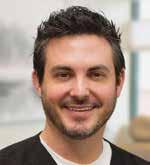


Woods Cross, North Salt Lake partner to build new dog park
The new park is an expansion of Legacy Dog Park at 2180 W. 2425 South, Woods Cross.
By Becky Ginos becky.g@thecityjournals.com
WOODS CROSS—Is Fido just itching to have a place to run around and meet new friends? How about a dog park? North Salt Lake City and Woods Cross City have joined together to build one on the border of the two cities at 2180 W. 2425 South, Woods Cross. The new park is an expansion of Legacy Dog Park at the same location.
The new park will be named Flash Cairo after two police dogs – Flash in Woods Cross and Cairo in North Salt Lake.
“It’s cool that we can pay homage to those dogs,” said David Frandsen, North Salt Lake Assistant City Manager. “Both canines were amazing and worked in both communities.”
The park sits on Utah Department of Transportation (UDOT) property. “It’s unused property so it’s nice to find a good use for it,” he said. “It’s a retention basin and it will continue to work as that.”
Woods Cross has a lot of basins, said Woods Cross Public Works Director, Sam Christiansen. “In the case of this summer we haven’t had much rain but it will still act as a basin. Hatch Park (North Salt Lake) has a retention basin. It’s a multi-purpose use which is a big benefit for both cities.”
Dogs are not allowed at Legacy Park because of the water park, said Frandsen. “Now we have a place for people to take their dogs.”
“There’s also access to the trail,” said Christiansen. “Dogs can go off leash in the park and run around.”
They’re still working out all of the details but the plan is to have a small dog area and a big dog area. “Small dogs would be up to 25 pounds and the large dogs, 25 pounds and higher,” Christiansen said. “We expect the dogs to be under human control at all times. We don’t want aggressive dogs. We want responsible owners.”
The park will be on the animal control map, he said. “They can’t be there all of the time but they’ll check in. Any dog related issues will go to dispatch. We expect owners to be self policing and an officer will respond as soon as they can.”
Amenities will include ADA ramps, drinking fountains,
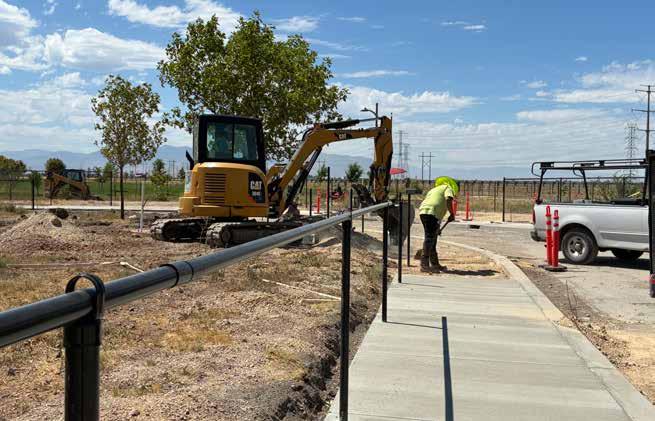
a shade structure and bench for owners to watch their dogs, said Christiansen. “There will also be doggy bags. Owners are responsible for cleaning up.”
“Eventually we’d like to put in obstacles and an agility course,” said Frandsen. “Things that are fun for dogs but low maintenance for the city staff. Between the two cities we’ll weed and maintain grass control, empty garbage cans, etc.”
It’s plumbed for a restroom, he said. “But we’re not doing that yet. We planted trees last year. We’ll keep adding onto it.”
The cities have been looking at other dog parks to determine what works or doesn’t work. “We’ve learned that in other cities that have had grass it’s a constant problem to keep it alive,” said Christiansen. “The concentration of dogs is hard on
it. Draper had grass for two years or so and stopped trying to keep the grass alive. It died off.”
Bountiful had grass in their park, he said. “It was too much to maintain so they threw bark down. We’re trying to balance amenities and cost.”
There is no set date yet for completion. “After all three areas open we’ll continue to look at adding trees, etc.” Frandsen said. “We don’t view this as a finished project.”
Props to both city councils for working together, he said. “It’s complicated enough with one but two?”
Employees are working hard on this, said Frandsen. “We’ve saved a lot of money by doing most of the work ourselves. It benefits both cities.” l
THE CITY JOURNAL TEAM
The City Journal is a monthly publication distributed directly to residents via the USPS and our Bountiful office.
For information about distribution please email hello@thecityjournals.com or call our offices. Rack locations are also available on our website. The views and opinions expressed in display advertisements do not necessarily reflect or represent the views and opinions held by Loyal Perch Media or the City Journals. This publication may not be reproduced in whole or in part without the express written consent of the owner. © 2019 Loyal Perch Media, Inc.
PUBLISHER
Bryan Scott | bryan.s@thecityjournals.com
EDITOR
Becky Ginos | becky.g@davisjournal.com
ADVERTISING EXECUTIVES
Mieka Sawatzki | mieka.s@thecityjournals.com
Lindsay Andreasen | lindsay.a@thecityjournals.com
Jason Corbridge | jason.c@thecityjournals.com
Ryan Casper | ryan.c@thecityjournals.com
Marc Davis | marc.d@thecityjournals.com
CIRCULATION COORDINATOR
Lydia Rice | lydia.r@thecityjournals.com 385-557-1022
Rack locations are also available on our website.
To subscribe to the weekly Davis Journal: subscribe.davisjournal.net
270 S. Main St. Suite #108, Bountiful UT 84010 801.901.7962
EDITORIAL & AD DESIGN
Ty Gorton Stacey LaMont
THE CITY JOURNAL
270 S. Main St. Suite #108 Bountiful, UT 84010 Phone: 801-901-7962
MISSION STATEMENT
Our mission is to inform and entertain our community while promoting a strong local economy via relevant content presented across

Arctic Circle celebrates 75 years, new Bountiful location reopens
The iconic Utah-based fast food chain is famous for inventing the original Fry Sauce.
By Becky Ginos becky.g@thecityjournals.com
BOUNTIFUL—Utahn’s
love their fry sauce and Arctic Circle – home of the original fry sauce – is celebrating its 75th year of serving the community. Founder Don Carlos Edwards and his sons Ralph and J.R. started the first location in Salt Lake City in 1950 as a food stand at Pioneer Days. Since then it’s not only expanded across Utah but into neighboring states as well.
Recently a new Arctic Circle restaurant opened at 2071 Orchard Drive in Bountiful after the old building was razed.
“Frank Christianson and Gary Roberts owned the location,” said Kasey Christensen, president and CEO of Arctic Circle Restaurants, Inc. “It was 55 years old and they had to make the decision whether to repurpose or sell. It made sense to bulldoze it and build it again.”
It’s been well received by the community, he said. “We’re glad we hung onto it and could continue our brand. The town has embraced it. Taking a 55-year-old building and making a new and nice one not only helps the community but us too.”
Christensen has been involved with Arctic Circle since he was 6-years-old. “I just turned 60 and I’ve worked in some form with Arctic
Circle during that time. In 1971 my mom and dad bought an Arctic Circle in Soda Springs, Idaho. At 6-years-old my job was cleaning the parking lot. My pay was that I got to keep any change I found and I also got unlimited ice cream cones.”
When he graduated from college in finance, Christensen said he didn’t think he wanted to work for Arctic Circle but got back in when a franchise needed a manager. He started on the franchisee side but moved over to the business side and worked his way up to become President/CEO.
Arctic Circle has become a staple in the quick restaurant space because of its commitment and involvement in the community, said Christensen. “We pay attention to detail with some unique food like our brown toppers (ice cream) black angus beef hamburgers and yellow flesh potato fries. We’re the only ones that have wild Alaskan halibut. Nobody else has that.”
Christensen said Arctic Circle does things a little differently. “We blaze our own trail. We’re innovative.”
“Congratulations to Arctic Circle Restaurants on 75 remarkable years of serving our Utah communities,” said Utah Gov. Spencer Cox. “From pioneering Utah’s beloved Fry Sauce to providing generations of Utahns with cherished memories and delicious meals, Arctic Circle represents the very best of our state’s entrepreneurial spirit and community values. We celebrate your success and look forward to many more years of Arctic Circle being a cher-

ished Utah tradition.”
As part of the 75th anniversary celebration, the restaurant will be rolling back prices over the coming months like 75 cent ice cream cones, 75 cent beverages and more, along with customer giveaways, merchandise and plenty of legendary Fry Sauce made from the original secret recipe created 70 years ago. “We want to be a legacy brand,” said Christensen. “We want to be around for another 75 years. We’re happy to be in the community. We want to be a good neighbor and serve with a smile on our face and be a good partner in the community.” l

Girls find their voice in A Bolder Way Forward Young Leaders Clubs
Student-led clubs give girls the opportunity to take on leadership roles.
By Becky Ginos becky.g@thecityjournals.com
Research at both the national and state lev-
el shows that Utah’s women and girls are struggling in several critical areas. The movement, A Bolder Way Forward (BWF) is meant to help girls, women and families to thrive.
A new program for teens called BWF Young Leaders Club helps girls see their potential to become a leader at school, at work and in her community.
“Basically we are trying to increase the leadership skills and knowledge around the different areas of Bolder Way Forward in the younger population,” said Steph Smith, colead for Young Leaders. “A lot of the (BWF) movement has been directed toward adults and a lot of who you see at the meetings and the summit are adults, but this very much affects the younger generation as well, so we wanted to get them involved.”
“We knew that our task originally was to reach out to organizations who are helping girls and young women learn about leadership,” said Jen Werner, co-lead. “What we realized is, yes, it’s great to learn about all of these organizations but what Steph and I saw is that there maybe is a gap between whether or not even some of these organizations are specifically helping girls.”
Do they even realize that what they’re teaching is confidence? she said. “That what they’re teaching is like being out there, be-

So anyone can be involved in the club, she said. “It’s student-led. When creating the framework we left it open for them to make changes if they want to later. Especially if the framework is used by different schools or groups, they can make whatever changes to their club that they want.”
It’s not just coming and sitting in meetings, said Smith. “It’s rather we’re coming to a meeting so we can plan an event, whether that’s an event to educate people or learning interviewing skills or networking.”
Adults will be there as support, she said. “You know administrative type of things particularly at schools but we really see it less as top down adults telling kids what to do and more kids taking that leadership role and initiative to create what they want.”
It’s a grassroots movement, Werner said. “We all started from our own small places and then we’re making this big web with all these different people and places so that we can bring them all together.”
“We’re always here for support and any resources that we have we’re absolutely happy to share,” Smith said. “But we’re not here to kind of dictate and tell people this is how it has to be.”
ing vocal, using who you are as a girl, being yourself and then understanding what that power means. It’s not that you should shy away from being who you are when you’re in mixed company.”
Statistics show that one out of five girls worldwide see themselves as a leader and even consider themselves where they might be a leader, said Werner. “They just don’t know what that means. Those words aren’t used often enough for them to start to see and under-
stand that in themselves and we see that even in women. Steph and I were thinking ‘well if we can get to that younger generation and we can teach them what we wish we knew at their age, then maybe by the time they’re older you know, they’re standing on their own.’”
“I’d like to add that with the clubs we also recognize that male allyship is important,” said Smith. “We think it’s important to reach boys as they become young men and help them to recognize leadership in women as well.”
“We’re passionate about leadership,” said Werner. “We need people to join us, then just help spread the word and get more things out there.”
For more information about how to start a Young Leaders Club in your area or to learn more about the program visit abolderwayforward.org or https://www.usu. edu/uwlp/files/a-bolder-way-forward/bwfyoung-leaders-clubs.pdf l
UDOT provides updates on I-15 widening project
UDOT is now in the procurement stage of the I-15 widening project which will follow a design-build model.
By Linda Petersen l.petersen@mycityjournals.com
CENTERVILLE—Utah
Department
of Transportation officials met with Centerville City leaders on July 15 to provide an update on the ongoing I-15 widening project, which is currently in its procurement stage. Michael Romero, a UDOT representative, informed the city council that the $2.9 billion project is moving forward and is expected to go out for bid in November.
The project will be a “design-build” contract, meaning a single contractor will be responsible for both the design and construction.
“But for us to even get there, we have to set kind of the bounds of that sandbox that
they have to play in, and that’s what we’ve been doing, and that’s where coordinating with the city staff and elected officials is very important,” Romero said.
Project timeline and challenges
Construction is anticipated to start in the spring of 2027 and last for four years. Romero noted that while UDOT is looking for ways to accelerate the timeline, they must balance that goal with managing risk. Eight firms have expressed interest in the project, with two considered “well-qualified” to move forward.
One of the project’s primary goals will be to keep traffic moving through the corridor while the freeway is under reconstruction, Romero said. To achieve this, UDOT will require that adjacent interchanges are not closed at the same time. A major challenge will be coordination with the Union Pacific Railroad, which is expected to take 15 to 18 months just for approval to begin construction near the tracks. This is particularly relevant at the Parrish Lane interchange and at 400 North in West Bountiful,
where the I-15 structure is adjacent to the railroad tracks.
Pedestrian bridges and property impacts
The widening project will include two new pedestrian bridges for the city, which will improve connectivity for recreational trails and multi-family housing. One crossing, planned for 1250 North, is particularly challenging due to high-voltage power lines in the area. UDOT will fund and build these bridges, which have a lifespan of about 75 years, but the city will be responsible for all future maintenance and liability.
The project is expected to impact several homes near Community Park. UDOT is in negotiations to acquire three homes north of the park, while several other homes will face partial property acquisition. Romero stated that UDOT is attempting to minimize impacts by adjusting sidewalk and park strip widths. Homeowners whose properties are partially affected, will be responsible for finding bids to replace torn-out items, such as landscaping or sprinklers, though UDOT will cover the
costs, he said.
Drainage and interchange aesthetics
The I-15 widening will also address an ongoing drainage issue. An existing “linear detention facility”(a type of stormwater management system designed to temporarily store and control stormwater runoff alongside roadways) in a swell area, will be impacted by the widening of the frontage road. To offset this, UDOT plans to provide more capacity under I-15 to get water out of the city faster.
UDOT is considering aesthetic improvements for the Parrish Lane interchange, such as decorative rock and potentially a city monument. The agency is working closely with the affected cities to ensure a consistent look and feel for the project as it crosses different city boundaries along the corridor, Romero said.
“What’s really important for us as an owner is we want to make sure that if you’re driving down I-15, you’re not seeing everything change with every city boundary,” he said. l
What can be done to save the Great Salt Lake?
The Great Salt Lake is home to over 330 species of birds and other animals like bison and pronghorn.
By Kelli Spackman
The City Journals
TheGreat Salt Lake is slowly drying up Climate change and evaporation, an increase in population, agricultural irrigation and human consumption of the lake water are all contributing factors to water levels dropping in the Great Salt Lake.
“As the largest saline lake in the Western Hemisphere, the Great Salt Lake is crucial to both people and nature,” according to the Great Salt Lake Shorelands Preserve. It’s shrinking at about four inches per year.
“I remember going there as a kid, thinking it was really cool and a good memory with my family,” said Elsie Swiderski, a student at BYU. “It’s sad to think that it’s slowly drying up. I’m always concerned when beautiful places are going to waste.”
The “bottom of the lake contains pollutants such as arsenic, lead, and mercury,” which can cause significant health concerns if released. (https://www.housing.utah.edu/whats-goingon-salt-lake/). The dust storms that come from the lakebed can be harmful to humans and can even cause respiratory illnesses. It also worsens our air quality. The exposed lakebed has a salty crust over it, so it helps prevent dust storms, but there are still toxic minerals in the lake that can be uncovered. The dust affects people all along the Wasatch Front. The dust from the lake can affect the snow, which can affect skiing because it increases the melting rate.
“Without intervention, the Great Salt Lake is on track to become one of the largest dust emission sources in North America,” according to Save Our Great Salt Lake.
During the winter, the water level rises, but because we have had really hot summers, the water level lowers in the summer.
“All of the snow from the 2023 massive year just brought the Great Salt Lake back to the minimum, entering into critical levels,” said Karyn Baxter, North Salt Lake City Engineer. “So, we really still need to be cautious.”
The aquifer levels are continuing to drop, and if there’s not enough water in the aquifer, we could accidentally take water from the Great Salt Lake. The lake is about 36% full, according to Grow the Flow Utah’s Great Salt Lake tracker.
“I am passionate about saving the Salt Lake and I wish that more action was taken immediately, especially with how much water is taken from it before it even reaches the lake,” said Ava Epling, another student at Utah State University.
History of the lake
The Great Salt Lake was once part of Lake Bonneville. In the early 1900s, there was an attraction near the lake called Saltair. Saltair was

originally built in 1893. It burned down in 1925 and Saltair II was built. It burned down in 1931 and was closed in 1958. Efforts to bring it back ended when it was burned down again in 1970 by an arsonist. In 1981 Saltair III was built.
The ecosystem there is collapsing
“I think [The Great Salt Lake is] beautiful. I can see it from my house, and it’s such a pretty view,” said Samantha Carpenter, a student at Utah State University. “It’s also a super important part of the ecosystem.”
The Great Salt Lake is home to over 330 species of birds and other animals like bison and pronghorn. Some of the birds eat the brine flies and shrimp, so if they die out because of too much salinity, the birds won’t have anything to eat. Less water in the lake can mean more wandering wildlife. Some of the birds, like pelicans, have been forced to leave altogether.
“I love the Great Salt Lake, especially the Farmington Bay area that is so crucial to bird migration,” said Epling.
There is also a significant population of brine shrimp, which are harvested and given to the fish and shellfish that we eat. Harvesting the brine shrimp eggs and selling them brings in millions of dollars. The less water in the lake, the higher the salt content, which makes the lake smell worse (the brine shrimp also contribute to the smell), and the extra salt isn’t good for the brine shrimp. They can’t survive in water
that is too salty. The salinity levels of the lake fluctuate between 5% and 27% according to Antelope Island State Park. The lake is divided. The microbiomes change the color of the lake. One side of the lake looks pink. It’s about 30% salt, which is close to 10 times what the ocean is. The other side has less salinity at about 15%, so life can develop. On this side, the water is either green, when the algae are present, or blue. The lake is so salty because there’s no outlet; it’s a closed-circuit system.
The lake has minerals in it and it provides valuable resources like magnesium, potassium, and salt. Many things are made using these resources, including soda cans, which are made of magnesium.
“The level of the lake is impactful to our greater community and to us directly,” said Baxter. The lake levels haven’t been this low in over 170 years. The decreasing lake can affect our water supply.
How can we help save the lake?
One of the biggest ways the community can help save the Great Salt Lake is by reducing outdoor water use and water consumption in general. This means watering our lawns even one day less per week. Using drip lines and switching to drought-tolerant plants can also help with this. Research shows that the lake will disappear by 2030, so we’re running out of time to save the lake.
Our state can have water delivered to the lake to help it rise. There has been some wetland restoration around the lake because the wetlands around the lake need to stay wet so that vegetation can grow. This vegetation provides shelter for the birds. Without that shelter, the birds would be easier targets for predators. There have been organizations that have helped save the lake and the wetlands. The Nature Conservancy (TNC) has “enhanced or created more than 400 new acres of wetlands on [their] properties, benefitting birds such as white-faced ibis, long-billed curlews, and great blue herons,” according to TNC.
“Restoring the Great Salt Lake to health will not be a one-year, one-policy, one-constituency solution,” said Brian Steed, Great Salt Lake Commissioner, Great Salt Lake Strike Team Co-Chair. “Rather, a coordinated, data-driven approach will be necessary so decision-makers can evaluate tradeoffs and balance competing interests.” The Strike Team can help with this; many researchers work with Departments of Natural Resources, Environmental Quality, and more. Another way we can help preserve the lake is by donating to companies like Friends of Great Salt Lake, Grow the Flow, and The Great Salt Lake Shoreland Preserve. We can also get involved in preservation groups. Talking to the legislature about the Great Salt Lake can inform them that saving the lake is important. l
Focused Graduation Pathway helps students get back on track
The program helps students who are significantly behind earn back those credits to graduate.
By Becky Ginos becky.g@thecityjournals.com
FARMINGTON—High school juniors
and seniors who are lacking the credits to graduate now have a way to make those up and walk with their graduating class. The Focus Graduation Pathway gives eligible students the opportunity to receive the support they need to earn those credits.
“In February the State School Board passed a rule that allowed students who are heavily credit deficient to take part in the Focus Graduation Pathway and stay enrolled in their high school,” said T.J. Strain, Davis School District Teaching & Learning Department Director. “Before, students had to withdraw and weren’t connected with their high school.”
It’s a statewide program, he said. “Districts can create their own policy and the school board approved ours. Now we’ll put it into action.”
The program is only for juniors and seniors, said Strain. “They have to have parental permission and they can’t use the credits to graduate early.”
Students must be significantly behind, he said. “At least six credits behind if they’re a junior and three credits behind if they’re a senior.”
The student, parent and counselor meet to set up a plan, Strain said. “A lot of students have a study skills class where they can really hone in on taking the GED. They take a pre-test to see if they’re eligible to take the full GED. If they pass they can get up to 13 credits.”
The GED areas are:
• 4.0 credits for language arts (Reasoning through Language Arts Test)
• 3.0 credits for social studies (Social Studies Test)
• 3.0 credits for mathematics (Mathematical Reasoning Test)
• 3.0 credits for science (Science Test)
This program doesn’t hit everybody, he said. “The vast majority of students go through regular classes. It could be a student that comes from out of state and didn’t get a lot of credits. We get a high number of homeschooled students. A lot of kids come back and don’t have the credits. Some are heavily credit deficient because we have no evidence of credits.”
Previously students could maybe go to adult education, said Strain. “A lot stay enrolled in their own school. For a 16-yearold they’re saying ‘I’m here but I can’t


graduate.’ This gives them a little hope and a light at the end of the tunnel.”
In the study class students have access to material to help them prepare for the GED, he said. “The GED is more robust than the ACT,” Strain said. “It focuses more on the overall learning in high school and where you’re at. The ACT is trickier to nail down where you are, the GED is tied to a specific standard.”
Students must meet all of the other graduation requirements, he said. “It’s by no means an easy option. They need to meet 27 credits to walk with their class or they can get a 24 credit diploma but they couldn’t walk.”
Strain said they always want kids to go the regular route. “The reality is some have dug their own hole. They could’ve just been lazy and didn’t do anything. There’s a variety of reasons why they’re behind.”
Some of their situations aren’t typical, he said. “They’re placed into the hole by no fault of their own. Sometimes things just don’t go their way. Some parents are incarcerated and navigating school on their own at 15 is hard for kids. We think ‘let’s see what we can do to help.’”
Strain said they’re not downplaying the regular route. “If we can get them back on track they don’t have to take the long road around to get back to where they need to be.”
The program will start in the fall, he said. “Anything new starts out clunky. We’ll transition over this year. The counselors are excited to be able to offer options.”
It’s been disheartening for them not to be able to help students, said Strain. “Now they’ll have options. I’m excited to see it come to fruition.” l




NEW AREA LARKIN




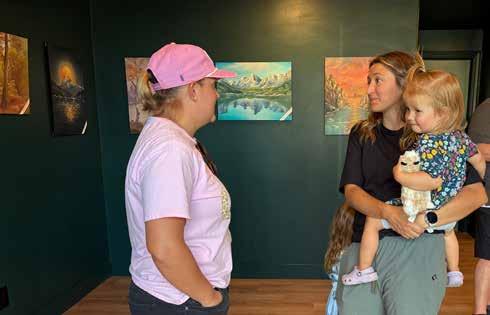
Small scale self-service events center offers space for all types of gatherings.
By Becky Ginos becky.g@thecityjournals.com
BOUNTIFUL—Looking
for a cozy venue for a wedding, high school reunion or other event? Wild Sage fits the bill. The events center offers a space where gatherings that are too big for a home can meet.
“It’s a small scale self-service events center,” said owner Megan Ericksen. “It’s an affordable way to get together if you don’t want to cram people into the living room. We get events from all across the board.”

There are tables, chairs and linens available, she said. “People can bring their own food or have a potluck. Bigger venues don’t allow that. I don’t charge based on the type of event, it’s by the hour.”
Wild Sage opened in April at 1480 Orchard Drive, Suite 113 in Bountiful. “I
saw the space and thought it would work,” Ericksen said.
In addition to owning the business, Ericksen is an artist. She recently held a pop-up art show at Wild Sage. “I like acrylics. I mostly do landscapes and I like bold colors. I’ve done art my whole life. It’s fun.”
Ericksen plans on hosting more community events. “I want to have local artists and food trucks. “I want to support a group of artists and help them build their dreams while I build mine. All together we can make this work.”
Wild Sage is also hosting a Grab & Go Packs event Sept. 22 supporting the Davis Education Foundation and their teen centers to provide grab and go packs for students experiencing homelessness. “Our goal is to put together 500 packs,” she said. “We want to help the kids in our area that face homelessness and food insecurity.”
To donate or volunteer to help assemble the kits visit https://wildsageutah.com/ products/volunteer-sign-ups. For more information about Wild Sage Events visit https://wildsageutah.com/. l



‘Americans and the Holocaust’ traveling exhibition coming to Davis County Library
Clearfield Branch Library is one of 50 U.S. libraries selected to host the exhibit.
FARMINGTON—A special showing of a traveling exhibition “Americans and the Holocaust” will be on display at the Clearfield Branch Library from Sept. 30 – Nov. 6. The library is one of 50 U.S. libraries selected to host the exhibit. The library is located at 1 N. Main St., Clearfield.
The exhibition is from the U.S. Holocaust Memorial Museum and the American Library Association (ALA) that examines the motives, pressures and fears that shaped Americans’ responses to Nazism, war and genocide in Europe during the 1930s and 1940s, a release said.
The touring library exhibition is based on the special exhibition of the same name at the Museum of Washington, D.C.
The 1,100-square-foot exhibition examines various aspects of American society: the government, the military, refugee aid organizations, the media and the general public.
According to the release, it tells the stories of Americans who acted in response to Nazism, challenging the commonly held assumptions that Americans knew little and did nothing about the Nazi persecution and murder of Jews as the Holocaust unfolded.
For more information about Americans and the Holocaust and related programming at the Clearfield Branch Library visit https:// bit.ly/44IYtEY. To learn more about the exhibition, visit https://exhibitions.ushmm.org/ americans-and-the-holocaust/main?ala
Americans and the Holocaust: A Traveling Exhibition for Libraries is an educational initiative of the United States Holocaust Memorial Museum and the American Library Association. Americans and the Holocaust was made possible by the generous support of lead sponsor Jeannie & Jonathan Lavine. Additional major funding was provided by the Bildners – Joan & Allen z”l, Elisa Spungen & Rob, Nancy & Jim; and Jane and Daniel Och. The Museum’s exhibitions are also supported by the Lester Robbins and Sheila Johnson Robbins Traveling and Special Exhibitions Fund, established in 1990.l
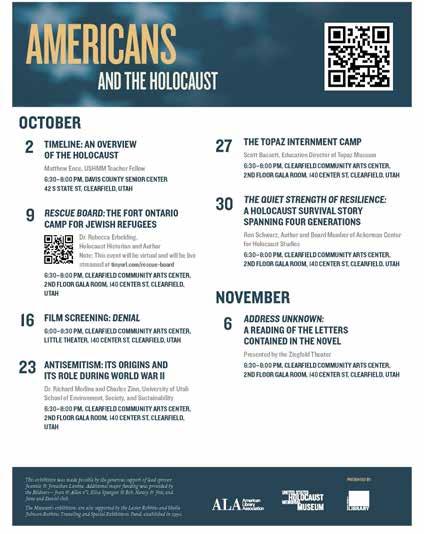

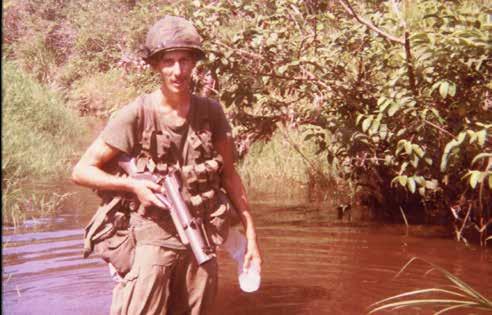

For the love of the game – local man inducted into Utah Softball Hall of Fame
John Decker is the chairman of American Legion Baseball in Utah. It is the 100th anniversary of the league.
By Becky Ginos becky.g@thecityjournals.com
FARMINGTON—It’s been 100 years since American Legion Baseball began and it’s still going strong today. Founded in 1925 in South Dakota after World War I, it has expanded nationwide with hundreds and hundreds of team leagues.
“Right after the war ended there was a concern about how to keep young men healthy and active,” said John Decker, chairman of the league in Utah and a member of American Legion John W. Sheets Post 27-Farmington. “People wondered how to do that and decided to start a youth baseball league.”
Today, the local American Legion Post supports a team, he said. “It’s usually the near-
est post. They provide equipment if needed, organize umpires and fields. We use the high school fields right there.”
The league is made up of mostly high school players but it’s open to 13-19-year-olds. “A state championship was held three weeks ago in Cache Valley,” he said. “The game was played at Mountain Crest High School.”
There was that small town spirit, said Decker. “During the game there were probably 200 people there in support of both teams. It was amazing.”
As part of the centennial celebration, Decker coordinated with the Ogden Raptors and Salt Lake Bees to hold an American Legion night. “In Ogden we gave American Legion coins to each of the players. There was a banner hanging as you entered the park. At the Bees game I was able to go on the field pre-game and walk the ball to the mound.”
Decker has had a lifelong passion for the sport and was recently inducted into the Utah Softball Hall of Fame. “It was a wonderful honor,” he said. “I was reluctant to accept it.”
He started in the San Francisco area and

has been playing for 61 years. “I started at 14 and I’m 75 now,” said Decker. “I was drafted in 1969 and went to Vietnam so I didn’t play but I carried a baseball in my backpack. We would have a two-day break to rest and I would throw the ball.”
While in Vietnam Decker was injured when a mine exploded and killed two other men. “I was standing about 10 feet away and I only had two pellets hit me,” he said. “They took me to a MASH unit and they patched me up and sent me back. One of the pellets was too close to my heart so they left it in.”
When he returned he jumped back in and has been playing ever since. “I stay in shape and I attribute that to softball,” he said. “I’ve made several All-Star games and have been named MVP in a couple of games. That’s an honor too.”
Decker also plays in the Huntsman Senior Games each year. “I’ve been going since I was 58,” he said. “Except when my wife and I moved to Washington, D.C. for two years. When we came back I continued to go to the Senior Games. I’ve gotten 15 medals.”

Everyone brings a team from wherever they live, said Decker. “There are hundreds of teams. It’s a great place to play.”
There are different divisions determined by age, he said. “I go as a 75-year-old player but I can also play in the 70-year-old division. I’m mostly outfield but sometimes I play first base.”
Decker’s dad played college baseball in Oregon. “He liked to play catch with his sons,” he said. “That’s what got me going. His mitt was an old piece of leather.”
He didn’t play little league though. “Church ball was where I really started playing.”
Decker plays in a Monday night league at Valley Park. “The oldest division is over 80 and they’re still playing,” he said. “A lot of wives are there. Their support is what keeps the men going.”
One of the great things is the camaraderie on the field, said Decker. “It stays with you. Even at 75 they’re your best friends. It’s been a blessing to me.”
It’s been a wonderful thing to play, he said. “I don’t plan on giving it up anytime soon.”l




Pets

What’s your pet thinking? This animal psychic knows
By Peri Kinder
If you’ve ever wondered if your dog is happy, your lizard is upset or your bird is mad at you, Jennafer Martin could help you find the answer. Martin is a pet psychic with years of experience communicating with animals, getting to the root of what’s bothering your furry, feathery or scaly pet.
By tapping into an animal’s emotions, Martin offers insight into their behaviors, fears and level of contentment. She first realized she could communicate with pets when she received a Teddy Bear Hamster for her 14th birthday.
“For three days, she was happy, playful and delightful, but on the fourth day, I felt she was sad,” Martin said. “She wasn’t sighing heavily, or anything like that, I just felt like she wasn’t happy…Two days later, she had 13 babies. I would think if you’re gestating 13 of anything, you wouldn’t be very happy.”
It was the first time she realized she could pick up on things other people couldn’t. It was easy for her to read the emotions of the animals and share that insight as a way to create better understanding between humans and pets.
Martin had been a tarot reader and energy worker for several years before she decided to become a professional pet psychic in 2013.
“Even if I’m reading for animals, I’m still reading for people, so they understand how interesting their animals are,” she said. “I’ve read for reptiles, rodents, fish and large animals like ostriches and horses.”
Whether it’s decoding a bird’s persistent squawking or helping a rescue dog settle into a new home, Martin said her work bridges the gap between human and animal hearts.
Most animals have the mental capacity of a 2- to 5-year-old and she doesn’t receive fully-formed guidance from the
pets. Instead, she feels their emotions, sees images or has an intuitive sense about what’s going on in the pet’s mind.
While reading for a French Bulldog, Martin said the dog kept sending her an image of something orange and puffy, and the dog didn’t like it. The owners couldn’t think of any blanket or clothing item that would cause her such annoyance until they remembered a Halloween costume from the previous year. They’d dressed her as Nemo, from “Finding Nemo,” made with orange, puffy fabric. Martin had picked up on the dog’s irritation with the costume, which the owners promised never to use again.
Holly Esch regularly reaches out to Martin for help with her six lizards and she believes it’s kept them healthy and happy. After her lizard’s partner died, Esch asked Martin how her lizard was coping with the loss and if he was open to meeting another lizard. When Esch was trying to hatch lizard eggs, she asked Martin to do Reiki energy work to keep them from dying off.
“I ask relationship questions about them because they’re kind of like humans,” Esch said. “They bicker, they fall in love, they have their own little dramas and they have their own little different personalities. [Martin] just knows a lot of things and offers another perspective.”
When a family’s rescue tortoise kept trying to escape, Martin let them know he was looking for a mate. She discovered why an anxious cat had stopped using its litter box and why a puppy wouldn’t use the bathroom outside if he was alone. When Martin’s sister had a cat dying from cancer, Martin let her know when it was time to relieve its suffering.
Martin is often met with skepticism and is sometimes “tested” by pet owners when she’s asked to work with an animal, but she’s fine with that. She said it’s not her job to convince anyone that what

she’s doing is real.
“It’s fine to come with a sense of curiosity or a sense of skepticism,” she said. “At the end of the day, hopefully you know a little bit more about why your pet thinks or feels or behaves the way they do. You don’t have to buy in on what I do, as long as you resonate with the message that I give.”
Animals don’t always see the world the way humans do. Martin hopes her ability to communicate with pets helps owners become more patient and un-
derstanding with “naughty” behavior, especially when the animal is trying to be heard.
“I’d say 90% of the time, they’re not trying to be difficult. They’re just trying to get their needs met,” Martin said. “Sometimes, they’re just a little misguided or misunderstood…If you understand your animal better, then you feel like you can take care of them better, and then everybody’s happy.”
To schedule an appointment with Martin, visit readingsmorebyjennafer.com. A publication covering local pets, their humans and their care around Davis County
Thinking about getting a pet? Here’s what you should know first
By Holly Curby | hello@hollycurby.com
Bringing a pet into your life is more than just welcoming a furry companion—it’s a commitment that can enrich your home and heart in ways you may not expect. Whether you’re considering a playful pup, a curious cat, or even a serene fish, pet ownership is a journey of responsibility, patience and deep connection.
Before you adopt or purchase a pet, it’s important to think beyond the cuddles and cute photos. Pets rely on us for their care, safety and happiness—and that takes preparation.
Deanne Shepherd, former director of Marketing and Communications at the Humane Society of Utah, outlines three essential things to consider before bringing a new animal into your home:
1. Do Your Homework
Choosing the right pet starts with understanding your lifestyle. Ask yourself:
• What type of animal fits your living space and daily routine?
• What’s the animal’s lifespan, and are you ready for that long-term commitment?
• Can you afford the time and money required for food, veterinary care, and other needs?
• Are there pet restrictions where you live?
Don’t choose a pet based on appearance or breed trends. Instead, research the animal’s temperament, care requirements, and compatibility with your lifestyle. The more you know, the more likely you’ll find a pet who thrives in your care—and vice versa.
2. Explore Your Adoption and Purchase Options
If you’re buying from a breeder, make sure they’re reputable:
• Visit their facility.
• Meet the animal’s parents.
• Confirm that veterinary care is part of the breeder’s practices. However, adoption is another meaningful route. Shelters are full of animals looking for a second chance. Many are already vaccinated, spayed/neutered and microchipped
– making the transition easier for you and safer for them. Avoid buying pets from parking lots or unverified online sources, as these often come with health or behavioral risks due to poor breeding practices. Pet scams are common, so always verify the legitimacy of the seller or organization.
3. Be Ready for the Commitment
Routine is vital for pets. From feeding schedules to exercise and bathroom breaks, animals feel safest and behave best when they know what to expect. Think through:
• Who will be the main caretaker?
• How will children participate in pet care?
• How will your current pets adjust to a new addition?
Initial and ongoing costs include:
• Essentials: food, toys, collar, crate, litter box, grooming supplies.
• Medical: vaccinations, annual checkups, spay/neuter procedures.
• Extras: pet insurance, boarding, training, or emergency care.
A pet is a long-term investment—both financially and emotionally—but one that often pays off in joy and love. It’s not just about responsibilities—pets give back in powerful ways. According to Forbes, pet ownership can:
• Increase physical activity and outdoor time.
• Lower blood pressure and cholesterol.
• Help reduce feelings of loneliness and depression.
The companionship pets offer is often irreplaceable, especially during life’s more challenging moments. Sometimes, despite best efforts, a pet may not be the right fit. If challenges arise that you can’t manage, it’s okay to reach out to a shelter or rescue group for help rehoming the animal. It’s far more compassionate than letting the situation worsen—for either of you.

Looking for more tips? Check out Season 2, Episode 10 of Holly’s Highlights podcast for expert advice on pet nutrition, toxic human foods, lifespan expectations, the truth about pet insurance, training techniques, managing pet allergies and more.
Listen on Spotify, Apple Podcasts, Pandora, Google Podcasts, or at www. hollycurby.com. Bringing a pet home is a beautiful decision—but only when done thoughtfully. With the right preparation, you and your new friend can enjoy a rewarding bond that lasts a lifetime.


Pet Photo Contest!

WINNER
Pet Name: Sam
Description: Sam’s the kind of cute that makes your heart melt—fluffy, soft, and effortlessly photogenic, with a blissful little smile that says he knows exactly how adorable he is. His luxurious coat and regal posture make him the definition of majestic charm.
Human: Submitted by Dani Williams



2ND PLACE
Pet Name: Finn
Description: Finn loves all things snuggles and is as sassy as can be!
Human: Submitted by Mindy Martin Tamburrion

3RD PLACE
Pet Name: Dax a Doo
Description: Dax is our baby boy. We call him our BGB. Big Giant Boy. He’s a snuggle boy and best little brother to Xico.
Human: Submitted by Kristi Dancer
STAFF PET PHOTOS
Pet Name: Phoebe
Description: Phoebe is a yellow Labrador retriever. She loves to play with people as well as other dogs. Whenever I visit my parents, I head to the backyard to play fetch with her. She’s developed a talent for catching things mid-air, and tries to do so during each throw. It’s hard not to feel wanted around Phoebe and she’s a great cure for even the roughest of days.
Human: Simon Mortensen | Writer

Pet Name: Hudson
Description: My siblings and I have wanted a dog for a long time. About seven years ago, my parents gave in, and we got Hudson. He only has one eye. He’s an old dog, so he lost sight in one eye because of a cataract. But he is still a great dog who loves to cuddle and go on car rides.
Human: Kelli Spackman | Intern
Pet Names: Biscuit and Kiki
Description: Biscuit and her English cream daughter, Kiki, are both golden retrievers. My brother gave me Biscuit as a puppy right before COVID. I had some kids with anxiety and I thought it might help. Dogs are a positive light in the house showing unconditional affection and a willingness to connect anytime. I love that my home has the ever-valuable, cuddle feature now.
Human: Kerry Angelbuer | Writer

Pet Name: Olivia
Description: We adopted Olivia from Quail Pointe Veterinary Hospital after she was rescued, along with her kittens, from a hoarding situation. While her kittens were quickly adopted, this momma cat had been left behind. She has brought us so much joy.
“Anyone who gets to share their home with a cat is lucky,” said Mansell. “They are wonderful, loving companions with unique personalities.”
Human: Cindi Mansell | Writer
Land and water turtles make excellent, long-term pets. Habitat building and turtle grooming are enjoyable and kids like to watch behavior and hand feed them.
By Kerry Angelbuer k.angelbuer@mycityjournals.com
Going to a pet store is a fun way to see a variety of animals that make good pets, but it could lead to bringing home one of the less furry, non-allergic possibilities, a turtle. That is what happened to Chelsea Kephart 14 years ago when she brought home her first “cute” terrapin, a water/land turtle named Galileo. Currently living in Layton, Kephart owns three turtles now that live in her sun room in two spacious habitats. Her most friendly turtle is her tortoise, named Copernicus, who lives on land and does not require water for swimming. Her 2-year-old son, Neil, likes to hand feed this turtle a romaine lettuce leaf. Finally she acquired her third turtle when an acquaintance was trying to rehome several pets left when children moved out. Since turtles can live over forty years in captivity, long term care plans should be in place. She named this terrapin, Francis Bacon, changed to Lady
Turtles are a rewarding, long-term pet
Francis Bacon when the he turned out to be a she.
Making turtle habitats can be simple or elaborate. Kephart’s land turtle has a broken flower pot laid on its side for burrowing. The water turtles require enough water for swimming, as well as a ramp where they can go and bask under a heat lamp and dry out all the “nooks and crannies.” Plants can be part of both the water and land habitat, safe varieties that turtles can eat. Her terrapins are fond of duck weed and water lettuce with a sprinkling of very edible snails. They also enjoy small gold fish and mandarin oranges, possibly because they look like goldfish. Turtles can take a turn in an outdoor kiddie pool as well as wandering around in the back yard. Some owners place a balloon around their turtle’s shell so that they don’t get lost while exploring.
Turtles can be transported in a box for show and tell. Even the water turtles can be out for a few hours. Children can help groom turtles with a toothbrush set aside for that purpose. Spaying water on a turtle can be enjoyable as the turtle may “dance, shake and look adorable.” Turtle shells can be waxed or oiled to keep them pretty and healthy. Kids show respect by scratching and petting gently avoiding the mouth. Turtles can harbor bacteria, so hand sanitizer or a good hand wash is a good way to



end an interaction. Kephart maintains that her turtles are smarter than most and so “avoided to radioactive goo, so they did
not become teenage mutant ninja turtles.” Turtles are great pets that are good with kids and stay put. l




From aspiring writer to published author: Layton local shines at F.E.S.T.
Festival-goers discover a local author with seven published books and a new sci-fi collection on the horizon.
By Stephanie Morales s.morales@davisjournal.com
Every Friday night in July and August, Layton Commons Park transformed into a hub of food trucks, live entertainment, vendors, and community connection for Layton F.E.S.T. The weekly event, which has become a summer tradition for families across Davis County, offers more than just good food and music – it gives local creators the chance to share their work. Among the many booths this year was one that caught the attention of book lovers: a display of novels by Layton-based author M.E. Hansen.
For Hansen, storytelling has been a lifelong passion. “I started writing when I was 9 years old, just for fun,” she said during the event. “But I began publishing my work in 2021 and since then, I’ve been able to turn my love for writing into something bigger.” In just a few short years, she has released seven books, available in both print and ebook formats through Amazon, as well as an audiobook version of her thriller, The Clear Creek Springs Killer, narrated by actor Kirby Heyborne.
Though this was her second year participating in Layton F.E.S.T. as a vendor, the experience was both exciting and rewarding. “It’s been wonderful connecting with readers here in my hometown,” she said. “Events like this are special because people can stop by, ask questions about

“Some are serious, others are more comedic, so there’s a fun mix.”
Her next big milestone is already on the horizon: a brand-new science fiction release planned for April 2026. While details are still under wraps, she hinted that readers can expect immersive world-building, unexpected twists and the same suspenseful style her fans love.
“I recommend my stories for ages 15 and up,” she said. “Some of the plots, like one about a serial killer being tracked by a widower, may not resonate with younger readers. But for teens and adults, the themes are engaging, suspenseful, and thought-provoking.”
Her approach ensures that her writing bridges audiences: complex enough to satisfy older readers, but accessible to teens who are eager for thrilling and imaginative stories. While her books stand out, Hansen emphasizes that being at Layton F.E.S.T. isn’t just about selling copies. It’s about building connections.
my books and really get to know me as a writer.” She also participates in Kaysville’s First Friday Festival, another popular community gathering spot for local creatives. What sets Hansen apart is her versatility. While she’s already built a following with her thrillers, she’s now expanding her creative reach. She is currently working on two short fiction collections, one in sci-fi/fantasy and the other in thriller/horror. “The sci-fi and fantasy stories have more of an elemental of suspense to them,” she said.
That sense of community is exactly what made Layton F.E.S.T. such a success. For authors like Hansen, it’s an opportunity to not only showcase their work but also to connect with the very readers who will carry their stories forward.
Hansen is eager to keep engaging with readers and sharing glimpses of what’s next. Whether it’s a thrilling new horror collection or her highly anticipated sci-fi release in April 2026, she’s proving that Layton has its own homegrown talent ready to make waves in the literary world. “Every book I write is a piece of me,” she said. “And having the chance to share that here, with the community I grew up in, is incredibly meaningful.” l

Cremation on the rise: Utah joins national shift in burial trends
The national cremation rate is forecast to reach 80% or higher by 2035.
By Cindi Mansell c.mansell@mycityjournals.com
Aquiet transformation is underway in the way Americans – and Utahns – approach end-of-life arrangements. Cremation is becoming an increasingly common choice in Utah, reflecting national trends driven by changing values, cost concerns, environmental awareness, and flexibility in memorial planning.
Historically, traditional burials have been the dominant choice in Utah. However, cremation rates are steadily rising. This is due to many factors: affordability; cremation typically costs less than traditional burial; environmental concerns; some choose cremation to minimize land use and reduce environmental impact; evolving perspectives; as societal and religious views broaden, cremation is widely accepted as a respectful and dignified option; and because of the flexibility cremation allows for regarding timelines and personalized service options.
Additionally, a more transient population and fewer religious prohibitions against cremation are contributing factors, according to the National Funeral Directors Association (NFDA). In an increasingly mobile society, families are often spread across geographical
locations, making it difficult to visit traditional burial sites regularly. Cremation can offer a more convenient option for memorial services and remembrance.
Kaysville Cemetery is responding to these changing preferences. The cemetery already offers cremation burials and is preparing to expand these services to better serve residents. In the current budget year, the city will begin Phase 1 of a new cremation and memorial area, located north of the cemetery office.
“We’re committed to honoring the diverse and evolving needs of our community,” cemetery officials said, highlighting a growing interest in more personalized and accessible end-oflife arrangements.
While the U.S. is steadily embracing cremation, other countries have long led the way. In Japan, for instance, cremation rates are near 100% – driven by high population density and limited burial space. In Hindu and Buddhist traditions, cremation plays a spiritual role, symbolizing the release of the soul. In contrast, religions such as Judaism, Islam, and traditional Catholicism historically discouraged cremation, though those views have softened over time.
The first crematorium in the United States opened in 1876 in Pennsylvania, but adoption was slow. It took over a century for cremation to become mainstream, and only recently has it overtaken traditional burial as the most com-

mon choice in many states.
Western states are leading the nation in cremation rates. Washington, Oregon, Nevada, Colorado, Montana, and Wyoming are projected to exceed 80% cremation rates by 2035. Experts cite cultural openness, environmental awareness, and geographic mobility as contributing factors in these areas.
This fundamental change in end-of-life preferences is prompting funeral homes and
cemeteries to adapt, with a growing focus on “green” options and innovative memorial alternatives. For the funeral industry, long reliant on casket sales and burial services, this shift represents both a challenge and an opportunity for reinvention.
In Kaysville and across the country, cremation is more than a practical choice; it reflects broader changes in how we live, die, and remember. l
Food collection drive planned for Day of Service on Sept. 13
Among the community projects planned for the 9-11 Day of Service is a food drive set for Sept. 13 in five Davis County communities.
As part of the annual 9-11 Day of Service projects in Davis County, the Bountiful Food Pantry is collecting donated food items. This year, food collection projects are set for Bountiful, Centerville, Farmington, Fruit Heights and Kaysville.
The events will be held on Saturday, Sept. 13 from 9 to 11 a.m.
Rebekah Anderson, executive director of the Pantry, said a location is set for donors in Kaysville and Fruit Heights. Food items can be brought to 590 North Kays Drive in Kaysville during those collection hours. For donors living in Bountiful, Centerville or Farmington, items should be bagged and left on front porches for collection between 9 and 11 a.m. on Sept. 13. She said the most needed items are canned meats and tuna, canned fruit, ra-
men/pastas, canned vegetables, cereal, canned soups/chili, baking supplies, diapers size 4, 5 and 6; baby wipes and feminine hygiene products. All donations are then provided to patrons of the pantry, and all labor the day is done by volunteers.
There is also an online component to the drive for those wishing to make a monetary donation. That can be accessed at https://givebutter.com/bSFJwx.
In addition to the food drive, several stakes of The Church of Jesus Christ of Latter-day Saints are assembling pantry
packs for distribution to students in the Davis School District. These pantry packs provide food for students in need over a weekend, and no one distributes more of these pantry packs in Utah than the Bountiful Food Pantry. Anderson said the goal for participating stakes could provide more than 6,000 of the packs.
More information on pantry programs can be found on its website at https://bountifulfoodpantry.org/ l




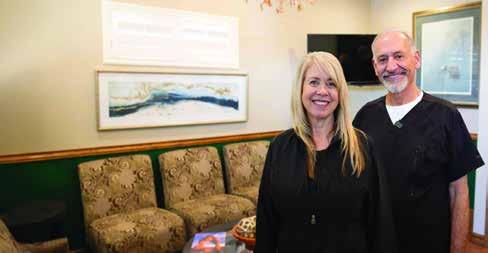

School board approves property tax increase
The Davis School District proposed a property tax increase of $12,725,298 for the 2025-26 school year.
By Becky Ginos becky.g@thecityjournals.com
FARMINGTON—A long line of residents stepped up to the podium to speak during a Truth in Taxation meeting of the Board of Education of the Davis School District meeting on Tuesday, Aug. 19. The meeting was to discuss a proposed property tax increase of $12,725,298 for the 2025-26 school year. Most spoke against the increase, questioning if it was necessary and if it benefits the students.
“The board’s goal should be to give our students the best education possible with an efficient use of tax dollars,” said one resident. “It is time for you to review where our money is being spent.”
It’s time to understand why those billion dollars are not creating a more effective teaching environment, he said. “I encourage you to do that, to ask the hard questions and give us real, transparent answers before you decide to take more money from people in these struggling times.”
Davis School District Business Administrator Tim Leffel started out the meeting with an overview of the district revenue sources and where the money comes from. “Almost 70% of our revenue comes from the state,” said Leffel. “Property taxes represent about 21% of the revenue the district receives. Some comes from federal and some comes from other miscellaneous things. So that will be important as we look at some of the actual tax notices that you received.”
Leffel likened it to envelopes divided into operations and capital. “In the operations envelope, it’s pretty much anything you would think about. What it takes to run a school, the principal, the teachers, the curriculum, the supplies. That is by far the biggest envelope in the district. It’s about $800 million total in that envelope.”
The capital envelope is very different, he said. “There are no salaries in the capital envelope. It is for equipment. It is for maintenance of our buildings. That’s the biggest cost we have. We have 11.5 million square feet of building space in the district. So carpet, paint, roofs, boilers, all of those things are the kind of costs that go through capital, as well as large things like school buses and large equipment.”
So this is the language that was presented in your tax notice, that there’s 12.7 million new dollars and that represents a 10% tax increase, said Leffel. “We’ve had some folks reach out and say ‘why do you need 10% more income in the district?’ So we just wanted to point out that the 10% is a 10% increase in just the property tax piece of the district budget, not the entire budget.”
“I live within a few blocks of Bountiful Elementary,” said another resident. “As I’ve watched it be built I’ve wondered with the decreasing enrollment why that school needed to be more than double the size of the old school. Lot of money was spent that I don’t think we needed to spend.”
He said that his property taxes have gone up more than triple what they were. “That tells me that budgeting is not happening the way it should. I have to balance my budget at home. It’s been very difficult, but I did it. I think you guys can too without raising the taxes so much.”
“I know there’s money involved here and my property
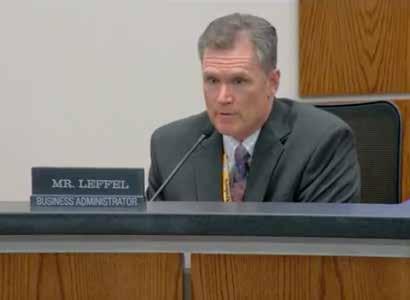
taxes will go up too, but I’m still in favor of this motion,” said one man. “It’s not about me personally. It’s not so much about the money as it is about kids. I want my grandchildren to have the opportunities I had and feel about their school the way that I did. That’s why I support this.”
After hearing from several other residents, each board member was given the opportunity to express their opinion on the tax increase. Councilmember Julie Powell proposed a decrease of $2 million from the tax increase. Ultimately, the rest of the board voted to accept the property tax increase of $12,725,298 as presented. l
Benefit from 40 Years Experience at Utah Implant & Denture Center
Dr. Ruedi Tillmann, DDS, has been practicing dentistry for 40 years and is an instructor at Roseman University School of Dentistry. He’s the owner of Utah Denture & Implant Center, which has been in business since 2024, providing implants, dentures and dentistry services, with an emphasis on implant-supported dentures.
Tell us about your business.
We o er comprehensive services matched with highly skilled experience and tailored to focus on patient comfort and care. We provide peace of mind through professional advice and treatment, contributing to overall oral health and con dence. Our ideal clients are patients seeking comprehensive care at a reasonable cost with excellent service.
What sets you apart from your competition?
I have spent more than 40 years providing excellent, friendly service at an a ordable cost. I emphasize patient comfort and care with a friendly sta and a comfortable environment. I have the experience and knowledge to help patients nd the right solutions to their dental problems.
What services do you provide?
We o er same-day implants, implant dentures, full mouth reconstruction, dental bridges, oral surgery, emergency dentistry and so much more. We also have a free consultation so patients can come in, ask questions and hear about their options.
What are implant dentures?
The contrast between traditional dentures and implant dentures is dramatic. Traditional dentures rest on the gums or upper palate, which can cause slipping, sore spots and frustration while eating or speaking. Implant dentures anchor securely to the jawbone, providing unmatched stability, a natural look and the con dence to enjoy life without limits.
What other denture options are available?
There are overdentures that use a snap-in technology that o ers great stability. Semi-removable dentures are a hybrid option for versatility. Dentures have changed signi cantly over the years, allowing people to have more freedom and ease.


What is your best advice for someone who is considering doing business with you?
Come talk with us. Have a consultation. We want to have open communication and be transparent about the expectations and services we provide for our patients. Sometimes people are worried about getting dentures or implants, but we make the process easy, simple and a ordable.
Do you o er nancing?
Our practice o ers several exible nancing options, allowing patients to get the treatment they need while enjoying a ordable monthly payments that t their budget. If someone has questions about nancing, they can contact us. We will walk them through the process of getting pre-approved over the phone. We don’t want the cost to hold them back from getting the services they need.
Why should people work with you?
I have experience that patients have trusted for decades. We provide specialized care based on a patient’s needs with lots of options to choose from. Along with dentures and implants, we o er general dentistry services for the whole family. We’re a familyoperated business with a passion for dentistry, o ering personalized, honest, dedicated care.
Utah Denture & Implant Center
690 N. Main Street, Kaysville | 801-717-0093 utahdentalimplantcenter.com
Splash of color: Art mural planned for North Salt Lake’s Main Street
Work is underway for a mural to be painted on the side of the building at 10 South Main Street across from Hatch Park.
By Megan Fisher m.fisher@davisjournal.com
The North Salt Lake City Council has approved plans for a mural to be painted on the side of the former Bamberger Hotel building at 10 South Main Street. As part of a citywide Mural Program implemented by the North Salt Lake Arts Committee, Community Development Director Sherrie Pace said that the mural and other similar art pieces coming to the city, will “add to the vibrancy of the City, encourage economic development in our Town Center, and hopefully bring a smile to the face of those who view the murals.”
The mural will be located on the north side of the building that is across the street from Hatch Park. The building is owned by the Montanaro family. David Montanaro, who recently passed away, was a self-taught artist and a resident of North Salt for over 40 years. The mural will be done by Jean Montanaro, his daughter and herself a highly accomplished painter with extensive experience with mural painting. As a way of honoring Montanaro’s art, the mural will combine two of his pieces, projecting them onto the building’s wall and then blocking them in with a stencil.
David Montanaro was born and raised in Providence Rhode Island. Originally he went to Brown University as a medical student, but while studying he discovered that his true passion was for art. His wife Sheila is also a talented artist, and together they raised nine children, and according to Jean,

“molded their lives around art.” In the early 1980s David and Sheila moved their family to North Salt Lake and became intimately involved in bringing art to the community. The Montanaro family are a familiar presence at arts festivals and farmers markets around Utah where they sell stone jewelry and paintings. They were some of the first vendors at the Salt Lake City farmers markets and have attended regularly for 27 years. Eventually, at the Bamberger Hotel property they opened the Original Way Gallery which, through frequent shows, provided a place for local artists to display their work. “His jewelry was something that he more easily put out there,” Jean Montanaro said about her father. “But his paintings and his art have not had too much exposure… and the mural is the first big step in getting it out there… I believe, whether it’s bias or not, that he’s one of the great artists of our time.”
The North Salt Lake Mural Program came about as a desire to beautify the city and drive tourism. In 2024, a member of the Parks, Trails, Arts and Recreation Advisory Committee approached the City Council with the idea to apply for a grant from the Davis County Tourism Department to use for the installation of murals throughout the city. With the success of similar projects in Salt Lake City, South Salt Lake and Midvale, the City Council accepted the proposal last February.
The cost of the mural is estimated at $7,500 – $10,000. The funding has been allocated for the project from the budget of the Arts Committee. The money will go toward the building preparation, paint and supplies, scaffolding, and artist compensation. Such a number was reached after conversations with the Montanaro family and research into similar art projects in Salt Lake City, South Salt Lake, and Midvale. The Mural Program was adopted by the City Council last February and money was set aside in the Arts Committee budget at that time.

According to Pace, the city will be applying for the Discover Davis Mural Grant program, which, if accepted, would be able to cover 50% of the total cost. Funding is not contingent on the Grant and if not awarded will still be able to be fully covered by the city.
“It’s important to remind people and young people, that art is something that’s worth having in your life… or to just appreciate,” Jean Montanaro said. “It’s something that can create an identity for the community.”
Work has already begun to prepare the wall of the Bamberger Hotel for the mural and Montanaro hopes that the art piece will be completed by the end of September or beginning of October. l

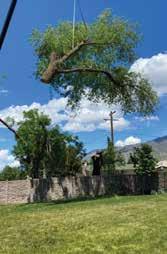


Scott Parke appointed Davis County Controller
By Becky Ginos becky.g@thecityjournals.com
FARMINGTON—There is a new face in the Davis County Controller’s Office. Scott Parke was selected by Republican delegates in a special convention and recently appointed by the commission as Controller, filling the position of Curtis Koch who left in July for another opportunity. Parke will finish Koch’s term that expires in January 2027. He intends to run in 2026 for a full term.
“I was working as the Clerk/Auditor for Weber County,” said Parke. “I really enjoyed the work but when this came up I knew I’d regret not trying for it. I’m sad to leave but it’s a rare opportunity here.”
It’s an added responsibility being an elected official,” he said. “I’m ready to dive in and get started to prepare for the budget season that starts soon.”
“Scott Parke brings exceptional financial experience and deep institutional knowledge to this position,” said Commissioner John Crofts. “I congratulate him on earning the trust of the delegates and look forward to working closely with him. Davis County is fortunate to have someone of his caliber stepping into this vital role.”
Crofts said that more than 50% of Republican delegates turned out. “Some cut vacations short or traveled long distances just to vote. That kind of commitment speaks volumes. Davis County has some of the most principled and engaged delegates anywhere in the state.”
Parke graduated in accounting at Utah State University and received an MBA at the University of Utah in information systems. “I wanted to get my CPA license,” he said. “I didn’t dream of becoming an accountant as I grew up. I fell in love with it. I felt like I could make a difference by keeping taxes low. It’s like a big ship. It takes a long time to turn. I want to be as efficient as possible.”
Parke said he wants to keep up with modern technology and use it to streamline processes. “I want to keep costs as low as possible. We can use technology to be more efficient. We don’t need to pay staff to do what could be done faster by a computer.”
For example, accounts payable, he said. “An invoice needs to be coded, scanned and purchase orders be validated. That takes time. That can automatically be kicked out by a computer. Instead of five minutes per invoice it can be done in five seconds. That saves a lot of time.”
Right now Parke said he’s in the information gathering stage. “I want to focus on talking to the right people and finding out what they’re doing and why they’re doing it and figure out a way we could do it a little better.”
Parke has four children and lives in

Clinton. “I enjoy being physically active,” he said. “I like to tinker and find out why something always works the same way and try to understand why it is still the best way to do it. Then tweak it and not let change be an obstacle. I want to see how it can be a little bit better and be more efficient. It makes life easier.”
He likes what he does. “I can’t imagine doing a job that I hate,” Parke said. “I’m excited to be here. I’m ready to go to work and eager to dive in and get started.” l


Are you a business leader? At no cost, the ElevateHERTM Challenge is easy to accept and will benefit your company. Join businesses across Utah in our mission to elevate the stature of women’s leadership. Take the ElevateHERTM Challenge and stand with other businesses as we pledge to elevate women in senior leadership positions, in boardrooms, on management teams and on politcal ballots.

LEARN MORE: www.wliut.com/elevateher-challenge

Davis School Board approves study of DLI program amid declining enrollment
By Becky Ginos becky.g@thecityjournals.com
FARMINGTON—Students in the Davis School District have the opportunity to learn a second language through the Dual Language Immersion (DLI) program offered in Spanish, Chinese and French. However, some of the schools are experiencing a decline in the number of students participating and the district is looking into the possibility of consolidating those programs into one school that offers the same language.
Secondary Director Chris Keime and Elementary Director Doug Forsgren came before the school board at the July 15 meeting to propose a study be made of South Davis Junior High’s French program and Lincoln Elementary’s Spanish program.

“There is a code that requires a study to be done before making any changes to special enrollment programs,” said Keime. “This is in connection with the French Dual Language Immersion program at South Davis Junior High School acknowledging that this study could result in consolidation or closure of that program.”
enth through ninth and for this coming year there are only eight.”
in the Davis School District.”
Enrollment in the French Dual Language Immersion program at South Davis has declined in recent years, he said. “There were 15 students enrolled across the three grades sev-



There are some factors that contribute to that that are worth studying, including a neighboring school, Mueller Park, having that same language immersion program, as well as the path that feeds the bridge program in high school resides at Bountiful High and not at the South Davis feeder school Woods Cross.”
“So the tentative thought is maybe consolidate that to Mueller Park?” said Board member Kristen Hogan.
“That is one of the options that’s worth studying,” said Keime.
“One thing we want to make clear is that the research on the Dual Language Immersion program is solid,” said Forsgren. “The state publishes good solid research on the outcomes. There are a couple of findings that show that students demonstrate measurable advances in language and content area assessments and that programs tend to offer students opportunities beyond because of looking at the bilingual skills that they’re picking up. However, we’re not seeing all those benefits reaped at Lincoln right now and there’s probably many factors that come into play.”
Forsgren said that is why they are asking for the study. “I wanted to point out just a little bit of information that kind of caught our attention as we were looking into this.”
The Center for Applied Linguistics published a study and the research showed that a minimum of six years in a DLI program is needed in order to show significant positive influence on a student’s academic outcomes, he said. “So part of one of the factors that may be contributing to this right now is just that Lincoln is one of our most mobile schools. It actually is our most mobile school. We have more students moving in and out of Lincoln than any other school
The Center for Applied Linguistics is looking for six years, said Forsgren. “Right now our average student is two and a half years in the program. As you dig into the research it shows there’s possibly something detrimental to students if they’re not in it as long and that’s something that’s in the same study.”
Typically there are great outcomes as students stay in the programs, he said. “The longer they stay the better.”
Behavior is also a factor, Forsgren said. “Typically your more intensive behavior students don’t go into the DLI program and that causes difficulty in balancing classes. It’s something that administration struggles with a little bit because the traditional teachers receive a higher portion of students that may have more challenges.”
“Lincoln is one of my schools that I hold really dear to my heart,” said Board member Michelle Barber. “So I just want to clearly say that this is the beginning of the study. Parents reached out to have students in the program. I have students in immersion and when you hear any change it is really frightening. So I think we’ll take a careful approach. We’re going to have open houses, we’re going to meet with parents and we’re going to see the best way that we can support all students at that school.”
“I remember years ago when they first started these DLA programs in Utah they talked about how even just studying a second language helps students achieve better academically,” said Board member Julie Powell. “But there’s always the question: is it correlation not causation?”
Ultimately, the board unanimously passed motions to initiate a study for both South Davis Junior High and Lincoln Elementary. l With declining numbers, school board approves study of Dual Language Immersion program at
The Guy’s Guide to Prostate Health: What You Need to Know
Prostate health may not be the most glamorous topic, but it’s a crucial one for men’s overall well-being. As men navigate their 40s, 50s, and beyond, understanding and prioritizing prostate health becomes increasingly important. This guide covers the essential things every guy needs to know about this small but vital gland’s role in male reproductive health.
As men age, the prostate can undergo changes, leading to various health concerns, including Benign Prostatic Hyperplasia (BPH), also known as an enlarged prostate, and Prostate Cancer.
Recognize the Symptoms – Don’t Ignore the Signs
Being aware of potential symptoms is crucial for early detection and management of prostate issues. Common symptoms to watch out for include:
• Frequent urination, especially at night
• Difficulty starting or stopping urination
• Weak urine stream
• Pain or burning during urination
• Blood in urine or semen
• Pain in the lower back, hips, or pelvis
“If you experience any of these symptoms, it’s essential to consult with your doctor. Regular prostate exams are vital, especially as you get older. Talk to your doctor about when you should start getting screened for prostate cancer. Screening typically involves a digital rectal exam (DRE) and a prostate-
specific antigen (PSA) blood test. Early detection significantly improves the chances of successful treatment for prostate cancer,” said Dr. Blake Johnson, a urologist at Holy Cross Hospital – Salt Lake.
BPH Treatment Options
The goal of BPH treatment is to alleviate symptoms and improve the quality of life. Treatment strategies vary based on the severity of symptoms.
For mild symptoms, lifestyle adjustments can be effective, including reducing fluid intake before bedtime, avoiding bladder irritants like caffeine and alcohol, following a healthy diet, and exercising, especially pelvic floor exercise.
Moderate symptoms often require medications that either relax the muscles in the prostate and bladder neck or shrink the prostate gland.
For more severe or persistent symptoms, minimally invasive procedures offer alternatives to traditional surgery.
• Prostate Artery Embolization (PAE): This procedure involves blocking the blood supply to the enlarged areas of the prostate, causing it to shrink over time.
• Prostatic Urethral Lift (UroLift): Small implants are placed in the prostate to lift and hold the enlarged tissue away from the urethra.
• Water-induced thermotherapy: Uses heated water to remove the extra prostate tissue.
In severe cases, surgery may be necessary to remove part or all of the prostate.
Prostate Cancer Treatment
Prostate cancer treatment depends on several factors, including the stage and grade of the cancer, the patient’s age, overall health, and personal preferences.
“For low-risk prostate cancer that is slowgrowing and hasn’t spread, active surveillance may be recommended. This involves regular monitoring with PSA tests, digital rectal exams, imaging (for example MRIs) and possibly biopsies, without immediate treatment,” said Dr. Leland Rogers, radiation oncologist at Holy Cross Hospital – Jordan Valley Cancer Center. “If the cancer is more aggressive, we have several treatment options, including surgery, radiation treatment or hormone therapy.”
Surgery – Radical Prostatectomy: Surgical removal of the entire prostate gland and surrounding tissues. This can be done through an abdominal incision or laparoscopically, using smaller incisions and a camera.
Radiation Therapy:
• External Beam Radiation Therapy (EBRT), uses high-energy beams that are targeted at the prostate gland to destroy cancer cells.
• Brachytherapy where radioactive seeds are placed directly into the prostate gland to deliver radiation internally.

Hormone Therapy reduces the levels of male hormones like testosterone, which can fuel the growth of prostate cancer cells.
“Taking proactive steps to understand and care for your prostate health is an investment in your overall well-being,” Dr. Johnson said.
If you have concerns about your prostate health, schedule an appointment with a urologist by visiting www.mountain. commonspirit.org/care-and-health/urology. For all healthcare needs, schedule a consultation with a primary care physician or a specialist at mountain.commonspirit.org.

Learn more about the services, care providers and missiondriven work of the Holy Cross hospitals and CommonSpirit Health at www.holycrossutah.org.

At CommonSpirit Health, we make the healing presence of God known in our world by improving the health of the people we serve, especially those who are vulnerable, while we advance social justice for all.
Holy Cross Hospitals have been trusted by Utah families since 1875.
For 150 years, Holy Cross Hospitals have cared for Utah families in their most tender, powerful, and vulnerable moments. From newborn checkups to post-op recoveries, we’ve seen generations through their highest highs and hardest days.
We’ve done it all with one purpose: to treat people, not just patients. We care for every person with personalized treatment powered by compassion and respect.
Our belief that we all hold the power to heal helps us provide care that spans generations and stands the test of time.
Learn more at mountain.commonspirit.org/holycross150
July water main break results in 1.8-million-gallon water loss
A July 14 water main break on Main Street led to 75 homes being without water and a 1.8-million-gallon water loss.
By Linda Petersen l.petersen@mycityjournals.com
CENTERVILLE—A massive water main break on July 14 left 75 Centerville homes without water for several hours, and officials are still unsure what caused the pipe to explode. The break, which occurred at 1450 N. Main St., resulted in the loss of more than 1.8 million gallons of water.
“Why does this happen? No clue,” Deputy Public Works Director Dave Walker told the city council the following evening. “There’s many reasons. It could be that the fluctuation in temperatures, the hot to cold that heaves the ground... [Or] an underlying defect that’s been in there for 40 years, just presented that day.”
The break on Main Street was dramatic. According to Walker, a 6-foot piece of pressurized 10-inch PVC pipe “literally exploded.”
“You would see the asphalt heave and water would come up and a piece of white pipe would float out,” he said.
The late-afternoon break took several hours for city crews to fix. The crews worked into the early hours of July 15 to complete the repair. Walker praised their efforts.
“A lot of our guys are three years or less here, some barely starting their second year, and still to perform at the level they did under the type of pressure that they had at two, three in the morning… and to even still see the spirits of the guys and the way they were behaving and interacting with each other even when we left at four in the morning it was still jokes and high spirits,” he said. “So it really is a really remarkable group that we’re fortunate to be a part of.”
“This is one of our more difficult areas to get shut down just due to older infrastructure, valves that don’t shut all the way, things like that that made it a little difficult,” Walker added. “It expanded the area that we had to have people shut down. So, it took a little while.”
The sheer volume of water lost was significant. Walker noted that the city’s new reservoir holds 1 million gallons. “So, this would have filled it twice,” he said. The nearby Chase Lane reservoir also lost about half a million gallons, but crews were able to shut down that area more quickly due to the terrain.
Walker believes that a UDOT project

to replace a stretch of Main Street five years ago may have contributed to the issue.
“It just seems like we didn’t replace some pipe during that time where we had a chance,” he said. “And that’s honestly the time where we should have found the funding to replace the pipe on Main Street when UDOT redid Main Street. But all that equipment, jostling, this is my theory, not necessarily theirs, but it just caused prob-
lems and probably crunched our pipes.”
The unexpected repair project is estimated to cost around $780,000. City officials are now considering options, including federal grants, to help pay for the project. In the week following the repair, crews returned to fix the storm drain, replace manhole covers, remove the old asphalt, and repave the intersection. l
Holly Rowe to be inducted into Utah Sports Hall of Fame Class of 2025
Woods Cross graduate Holly Rowe will be inducted into the Utah Sports Hall of Fame on Sept. 22.
By Tom Haraldsen
t.haraldsen@mycityjournals.com
In the fall of 1983, a Woods Cross High student started working as an intern for the Davis County Clipper newspaper. The opportunity began an amazing career for nationally renowned sportscaster Holly Rowe, who will be inducted into the Utah Sports Hall of Fame at its annual dinner on Sept. 22.
She will be part of the Class of 2025, joining sports greats Mary Kay Amicone, John Buck, Wally Joyner and Stew Morrill. Her career after graduating from Woods Cross in 1984 has had an interesting trajectory. Once she started studies at the University of Utah after transferring from BYU, the late Dirk Facer (a former sports editor at the Clipper) brought her onboard of the staff at the school’s Daily Utah Chronicle. From there, she worked for several local media outlets and eventually found her way to ESPN in 1998 as well as working as the first female analyst for Utah Jazz telecasts.
In an article written by legendary local sportswriter Kurt Kragthorpe for the USHOF, he said, “The poise, enthusiasm and knowledge that Holly Rowe exudes during the ESPN/ ABC telecast of the biggest college football game of the week are the same traits she once displayed during University of Utah women’s basketball radio broadcasts.” She told
him
“I’ve had a cool, awesome life.”
Holly Rowe has become a fixture on ESPN and ABC broadcasts of college football, women’s collegiate sports and the WNBA. Last season she focused on women’s college basketball, becoming an expert of WNBA star Caitlin Clark. She’s won three Emmy Awards, has been recognized with the Mel Greenberg National Media Award from the Women’s Basketball Coaches Association and received the Curt Gowdy Electronic from the Naismith Memorial Basketball Hall of Fame.
She also is a fighter, having been diagnosed with cancer in 2015, a battle she bravely fought by talking about her diagnosis with her broadcast partners and the incredibly large audience of fans and admirers. She has become a student of the game – all the games – and is one of the articulate and knowledgeable sportscasters in the industry. As she told Kragthorpe for his article, “I am obsessed with my job. Mostly because I love sports, as in I really, really, really love sports.”
The other members of the Class of 2025 include Amicone, who compiled more than 800 victories as a softball coach at Weber State, SLCC and BYU; Buck, a Taylorsville High graduate who played Major League Baseball for 11 years for Toronto, Miami, Seattle, Pittsburgh, the Los Angeles Angels and the New York Mets; Joyner, who went from BYU to MLB where he played for 16 years for four teams, compiling a .289 batting average in 2,033 games; and Morrill, long-time basketball coach at Utah State for 17 years whose teams won nearly three-fourths of their games under his tutelage.

The Sept. 22 inductions will be held at the Little America Hotel in Salt Lake City. For reservations, go to Utahsportshalloffame.org. l
Layton business puts a new world at customers’ fingertips
“Not everyone that walks in our doors buys something and we don’t ever really expect that,” said Alvey. “We’re kind of a place of community and then we also have stuff that you can buy to get your pro setups or get, you know, your dream setup or something like that too.”
By Simon Mortensen s.mortensen@davisjournal.com
Utah is widely regarded as a staple destination for extreme sports. A state that hosted both the X-Games and Tony Hawk’s Vert Alert this summer, it’s known for its mountainous slopes, its skateparks and “the greatest snow on earth.” This status has brought several enthusiasts to the area. Now a new movement is on the horizon – one with small boards and a dedicated community.
On June 14, co-founders Shaun McBride, known online as Shonduras, and Clark Checketts introduced Layton to Skatestation: Utah’s first brick-and-mortar fingerboard business.
“We get a lot of brand new people who are just learning about fingerboards coming in and then we also have the people who have been fingerboarding for 20plus years,” said Ethan Alvey, manager at Skatestation. “Those people are all mingling, getting together and just having a good time.”
An activity where riders use their fingers to control a miniature skateboard, Skatestation not only supplies fingerboarders with new parts, decks and obstacles, but a place to indulge in the hobby. The ambiance of the store matches that of a traditional skate shop, with exposed brick and a worn-down floor complimenting walls of apparel. Set up across the shop are miniature parks as well, each featuring a variety of ramps and rails to string together tricks from.
Those looking for more need only to ask an employee to access the business’ underground park area – a basement filled with setups to skate from.
Checketts and Alvey, as well as Checketts’ brother Seth, first got into fingerboarding through the famous Tech Deck toys. Coping with boredom at a call center job in college, Checketts became more invested in the activity and began skating with friends. It was during the pandemic when he began working with his 3D printer to create parts and obstacles to skate on.
During that time, the three began promoting and hosting fingerboard events on social media. Meeting with other enthusiasts in Alvey’s father’s basement, they created a more significant following – connecting them with McBride. After teaming up with the local internet personality, they began hosting events from McBride’s warehouse.
Today, the shop hosts all gatherings. That said, a lot of Skatestation’s work still takes place at the warehouse. An entity within McBride’s Spacestation company, the fingerboard operation has a dedicated space in a facility that houses e-sports efforts and social media production resources. Balancing their Skatestation responsibilities with day jobs, Checketts and his staff work to create new items for the shop from the building. One of those is Dude Guy Fingerboard – a company Checketts started that’s known for creating high-end fingerboard wheels.
“I really love this and if it made me zero dollars and I could make it work, I would still do it,” said Checketts. “When I am doing my fingerboard work, I’m not clocking in and checking my hours and making sure I’m getting paid enough. I’m just doing what feels fun and cool, and hopefully it all works out at the end of the day.”
Much of what separates Skatestation’s products from others in the fin-





gerboard industry is the quality. Each Skatestation deck is built from traditional skateboard materials, rather than just plastic. Most of the parks have also been built by Checketts, his brother and Alvey.
Though new to the area, Checketts and McBride have their sites set on the future, with discussions of a second Utah location in the works. According to Checketts, this would likely be a smaller location, and po-
tentially reside within a skate shop.
“This is definitely super trial run test, like figure it out,” said Checketts. “I obviously am like going to do everything to make this succeed, but I’m also just kind of like figuring this out.”
Skatestation is open on Thursdays and Fridays from 3-9 p.m. as well as Saturdays from 10 a.m. - 10 p.m. at their location on Main Street in Layton. l




Comcast invests in job training through workforce development grants
The national cremation rate is forecast to reach 80% or higher by 2035.
By Peri Kinder peri.k@thecityjournals.com
Workforce
development plays a vital role in Comcast’s digital opportunity initiatives. Through partnerships and grant funding with community organizations, Comcast expands access to tools, training and technology, the very resources necessary for success in this digital economy.
Designed to narrow the digital gap and empower all Utah communities, Comcast’s programs help fund, educate and build a strong future in technology for the State of Utah.
Corinne Bird, grant administrator at YWCA Utah, applied for a Comcast grant to expand digital skills for children and teens at the organization. By enhancing digital literacy, the program improves technology competency and career preparedness for youth.
“Partnering with Comcast helps YWCA Utah bridge the digital divide and open doors for the youth we serve,” she said. “Together, we’re building skills, confidence and career readiness, giving every young person a real shot at a brighter, more connected future.”
Youth at YWCA Utah often have limited access to computer training. Through a Comcast grant, the program breaks down barriers to technology by focusing on three areas: tech safety, computer skills and coding.
At the Suazo Business Center, a Comcast grant pays for digital marketing classes for entrepreneurs. As technology changes traditional marketing methods, the courses help low-income small business owners to learn modern strategies for the digital economy.
“It’s tough out there for small businesses, but our partnership with Comcast helps Suazo Business Center give entrepreneurs real digital marketing tools to grow their businesses,” said Suazo Business Center President and CEO Silvia Castro. “By building stronger brands and reaching wider audiences, we’re helping small business owners compete and thrive in today’s digital economy.”

Language programs provided at Elevate Utah assist new Americans and individuals experiencing income limitations with essential technical and language skills, helping them navigate an increasingly digital world and secure better employment opportunities.
The Elevate Utah Comcast grant covers the cost of advanced computer classes and an English program designed to address digital workforce literacy. Elevate Utah has served immigrant populations for more than 20 years by offering courses to help individuals break down barriers to employment.
“Partnering with Comcast helps Elevate Utah equip communities with the digital and language skills they desperately need to succeed,” said Elevate Utah CEO Jackie Larson.
“Together we’re changing lives by opening

doors to employment and creating a path to prosperity. This collaboration shows our shared dedication to bridging the digital divide and creating real opportunities for everyone to succeed.”
Utah Schools for the Deaf and Blind Education Foundation applied for a Comcast grant to help with assistive technology to connect children to the world, improve communication and increase learning opportunities.
“Our partnership with Comcast is opening doors for Utah’s deaf, blind, and deaf-blind students through powerful assistive tech and digital training,” said Amy L. Zaharis, USDB Education Foundation Executive Director.
“It’s amazing to see what can happen when we work together to break barriers and give every student the tools to connect, grow and thrive

for a future without limits.”
Through the Comcast grant program and digital opportunity initiatives, the school can offer devices and programs that include BrailleNote Touch, iPad, Braille Sense, EyeOn Technology, smart glasses and screen magnifiers.
“At Comcast, we are deeply committed to empowering Utah’s communities by bridging the digital divide and fostering economic growth,” said Deneiva Knight, Comcast External Affairs Director for the Comcast Mountain West Region. “Through innovative partnerships with local organizations, we’re equipping individuals with the tools, skills, and opportunities they need to thrive in today’s digital economy. Together, we’re building a stronger, more connected future for all.” l













City council authorizes new website contract
Centerville is getting a new city website with enhanced features
By Linda Petersen l.petersen@mycityjournals.com
CENTERVILLE—During its July 15
meeting, the Centerville City Council authorized a new contract with GovStack Inc. for a complete redesign and rebuild of the city’s website.
A few months back Administrative Services Director Bryce King and other staff members met with the city’s current web designer to look at a redesign of the city’s site but quickly realized to do so would be prohibitively expensive, so they began to explore other options, King said.
“We kind of just pumped our brakes and said, ‘Look, this is ridiculous. We should own this site, not you,’” King told the city council in a July 1 update. “We couldn’t have any other custom features or be able to grow with the times, and so we wanted to go with a company that would allow us to have more control and be able to evolve the website as technology evolves.”
They eventually settled on GovStack which utilizes a user-friendly WordPress management system that will include accessibility for people with disabilities, integrated com-

munication, including a new “text us” feature that will allow residents to directly text specific departments, such as Public Works, to report concerns, bill pay, which will make it easier for residents to pay their bills, and customizable content. Departments will be able to add customized menu buttons, social media feeds and videos without incurring extra costs.
“I’ve been really impressed with GovStack and what they have to offer, because it’s a lot. It’s a lot easier access,” King said. ‘They’ll also help us make it so that we don’t have hundreds of pages.”
The city’s website is “a critical communication tool,” he added. “We need to get better at this, and our website needs to be a little bit more responsive to our residents and dynamic to our needs at the time.”
The total cost for the website for the first year will be $24,399.50, which includes a onetime design fee of $18,165 and an annual fee of $6,234.50. The annual fee will be the recurring cost in subsequent years, a significant reduction from the city’s previous provider, which costs $17,500 annually. The one-time design cost of $18,165, combined with the first year’s annual fee, will use up the city’s allocated budget of $25,000 for the project. Additional features, such as the text/chat function, will be considered in next year’s budget.
At the meeting, council members discussed a clause in the GovStack contract that
states the annual increase would be the greater of 5 percent or the inflationary index. After a brief discussion, they authorized staff to negotiate this clause, with a goal of capping the annual increase at 3 percent or an inflationary index, whichever is lower.
Despite this concern, council members expressed strong support for the new website.
“This makes me really happy,” Councilmember Cheylynn Hayman said. “I hate our website. It’s not functional, and I’m really excited.” l


Local golfers finish among leaders at Korn Ferry PGA event
A great weekend for Davis County-connected golfers at the Utah Championship
By Tom Haraldsen t.haraldsen@mycityjournals.com
Several golfers with Davis County and Utah ties enjoyed success at this year’s Utah Championship. The Korn Ferry Tour event at the Ogden Golf and Country Club, presented by Zions Bank and Intermountain Health, hosted large crowds to cheer on their favorites.
Among them were longtime PGA player Daniel Summerhays of Kaysville, Davis High and BYU graduate Cole Ponich of Farmington, and part-time resident Preston Summerhays who spent much of his early years living in the county. His coach and father Boyd Summerhays, along with Preston’s sister Grace (who caddied for him), are former county residents now living in the Phoenix area.
Ponich, playing in just his third professional tournament since leaving BYU, finished tied for 22nd place (along with Daniel Summerhays, closing at 12 under, six shots behind winner Julian Suri of California). It was his highest finish on the Korn Ferry Tour and qualified him to play in the Omaha event
Aug. 7-10.
“I’m happy to know that I can come out here and compete with these guys,” Ponich said. “I definitely didn’t feel like I had my best game all around for four days, but it’s always a good sign when you’re right there in the top 25, even if you don’t feel you played your best. I’m happy to know that even with my B-minus game I can still compete with these guys. That’s the way it is on this Tour. If you get hot, even with a B-minus game, you can still make the cut.”
Following his round, Ponich was surrounded by lots of young fans anxious to get any kind of signed souvenir they could. He asked his caddie, Davis High grad Max Landon who was the Region 1 medalist in state last year for the Darts, to “just hand me all the golf balls” (left in his bag), which he signed along with his gloves and lots of fans’ hats.
Ponich is a social media star, with 60,000 followers in TikTok and 10,000 on Instagram. He is working with a longtime friend to “document the process of becoming a professional golfer and the grind of hopefully eventually getting to the PGA Tour.”
Preston Summerhays (who is Daniel’s nephew) enjoyed his best professional finish in seventh place at 15 under closing with a final round of 65. He had a 12-foot putt for birdie on the finishing hole that would have
Better Shelves. Custom Solutions.

tied for the lead before Suri’s fast finish that moved the winning score to 18 under. Preston took home a little over $26,000 for his finish.
“I drove it extremely well on the most scoreable holes,” he said post tourney. “When the course does kind of give you the opportunity to make birdie, I took advantage of those holes and hit great drives. I felt like I could have made a lot more putts today but I still made a decent amount. Overall I felt really good.”
He told Grace, a collegiate star golfer at Arizona State herself, that “if we just don’t make any bogeys, I know I’m going to make four to six birdies a round. On any course that will be a solid round. Taking advantage of the easy holes and not getting too greedy and not making big numbers on the other holes. It was a lot of fun having Grace on the bag–she knows that if I’m a little funk she knows how to snap me right out of it.”
Daniel Summerhays also finished at 12-under, but started hot on Sunday with birdies on three of the first six holes before fading a bit and finishing even par for the day. He’s coming off back surgery from February but says he feels better than he has in years. Summerhays was a fixture on the PGA tour for several years and is working his way back towards a return in the future.
Ogden Golf and Country Club hosted the Utah Championships for the first time,

and has a three-year agreement to host the tour. That follows Oakridge Country Club of Farmington which was the site of the tournament for many years. This year’s purse was $1 million with Suri taking the top prize of $180,000. l









































By Cindi Mansell c.mansell@mycityjournals.com
Kaysville City Manager Jaysen Christensen recently delivered what he believes to be the city’s first-ever State of the City address – or at least the first in many years. Drawing from departmental reports and key performance indicators from the past year, the presentation offered a
comprehensive overview of city operations, priorities, and challenges.
Christensen began on a high note, saying that Kaysville earned several Reader’s Choice Awards from the Standard-Examiner and the Davis Chamber of Commerce. The city was recognized for Best City to Live In, Best Fire Department, Best Parade, and Best Library.
Kaysville Police handled around 11,000 service calls in the past year, averaging about 800 calls per officer. Approximately 450 of those cases were referred to the Investigations Division, where three detectives managed roughly 150 cases each.
While traffic stops increased, citation rates remained steady. Christensen noted that the city saw 500 auto accidents in 2024, with 53 classified as serious. In response, the modified budget now includes funding for an additional patrol sergeant to enhance traffic enforcement.

Davis School District. The facility will feature multipurpose fitness rooms, exercise equipment, and a second-level walking track. Design is expected to finish by October 2025, with construction bidding in winter and an expected opening in late summer 2027. The Parks and Recreation Department currently manages programming for more than 13,000 participants and is already planning future offerings for the new center.
New construction permits – including single-family homes and townhomes – have declined, which Christensen attributed to broader economic trends. The Community Development Department is working on a downtown revitalization plan and ongoing city code updates. With a new planner now on staff, the city hopes to allocate funding for additional outside planning assistance.



The regional SWAT team responded to 21 incidents during the year, and the city’s multi-agency Narcotics Task Force seized 500 pounds of methamphetamine and 1.4 million fentanyl pills. The task force was recognized as “Task Force of the Year” by the Rocky Mountain HIDTA (High Intensity Drug Traffic Areas), which spans several western states.
Kaysville was recently ranked Utah’s second-safest city for two consecutive years but dropped to fifth place in 2025. Christensen cautioned that such rankings can be misleading, as cities with higher commercial activity often report more crime due to non-resident activity.
The Fire Department responded to approximately 2,000 calls in 2024, including 250 mutual aid responses – primarily to Farmington. The department implemented a Rapid Sequence Intubation (RSI) protocol, allowing responders to take over a patient’s breathing in critical situations. The department is on pace to exceed 2,300 calls in 2025. Christensen praised the Fire Department’s active social media presence as an example of successful public engagement.
Christensen reported an uptick in water line failures – particularly in areas with high iron content soil that deteriorates cast iron pipes faster. The city averaged 130 water repairs annually in 2022 and 2023, but numbers are now rising. To address this, the city has adopted a rate forecasting tool, Waterworth, to help model future costs and adjust rates accordingly. Notable infrastructure projects include improvements along Mutton Hollow and Main Street.
Unscheduled power outages rose from 35 in 2023 to 81 in 2024, largely due to a new outage management system that now tracks even brief disruptions. Despite the increase in reported incidents, service availability remained high at 99.98%.
Christensen praised the new system’s effectiveness, citing a recent example where an outage was resolved within 35 minutes – coordinated remotely via mobile app.
Major power projects included: Rebuilding the King Clarion area infrastructure (30+ new poles); Completion of the Shick Substation; Launch of the new Burton Substation project; and Fast replacement of a transformer at Shick to prevent service disruption. Waterworth is also being used to project future power costs and aid in rate planning.
Christensen announced the new “Kaysville Recreation Center,” renamed in coordination with Mayor Tran and the
Approximately 70–80% of Kaysville’s general fund is allocated to personnel –standard for a service-based organization. Full-time staffing grew from 81 in 2014 to 127 in 2024, driven largely by the transition to a full-time fire department beginning in 2018, which added 21 positions.
In the last 30 years, Kaysville’s population has doubled – from 16,000 to 33,000 – while non-fire full-time staff grew from 51 to 104. Christensen emphasized that staffing growth has kept pace with increased service expectations, including school resource officers and in-house legal counsel.
Christensen concluded by outlining future key strategic priorities: Public Safety enhancements; Utility infrastructure investment; staffing needs; and future use of the Operations Center and former library building. He also noted ongoing economic development efforts and downtown revitalization, as well as a push to improve road and trail connectivity in partnership with UDOT. Beautification projects and improved city communication are also priorities.
Christensen encouraged the City Council to provide feedback and expressed a willingness to include added metrics or data in future updates. l



It’sbarely September and social media pages are already flooded with autumn recipes, pumpkin hacks and tips on how to dress for sweater weather. For Utah, sweater weather in September is just dumb because it’s still 90 degrees in the shade. Wear a cute, fall pullover at your own risk.
Instagram influencers suffer from September insanity, bizarrely excited to roam through corn mazes (nature’s escape room), decorate porches with scratchy hay bales and crooked scarecrows, and stage family photo shoots at apple orchards with everyone grumpily dressed in red and black flannel.
In September, you’re legally required to wear a wool scarf when ordering at Starbucks, where each drink has a dash of cinnamon. Pumpkin spice is everywhere, from pancakes to deodorant, popping up out of nowhere like political yard signs and herpes.
These aren’t necessarily bad things. I love me a plaid shirt and fresh-baked apple crisp, but until Monday, Sept. 22, at 12:19 p.m. (MDT), it’s still summer and I will behave accordingly.
Here’s what shouldn’t happen before Sept 22: high school sports, pumpkin patches, hay rides, the NFL. None of those are summer activities. Nada.
Even if the temperature drops to 45 degrees by mid-September (which it won’t), I’ll still wear flip-flops and gym shorts as

Stop Pretending it’s Autumn

my casual work outfit. Well, flip-flops only if I’m going somewhere fancy, like Dollar Tree. I might as well not own shoes during the summer.
After going barefoot since April, my feet have reached the hardened leather stage where I could safely walk across a lava flow. My granddaughter recently poked my heel and asked, “What happened to you?” I tried to explain the development of callouses due to traversing 110-degree asphalt with no shoes, but she’d already turned her attention back to Roblox.
Even Mother Nature betrays me as the Wasatch Mountains start to turn a brilliant red, orange and gold. Sunset gets earlier each night, disappearing a little bit at a time, like when I’m trying to sneak out of a networking event. The air takes on a distinctly “autumn” glow, but that might be arsenic floating over from the Great Salt Lake. Living in Utah is exciting.
Farmers’ markets are still open, but

the options quickly turn from juicy, sweet peaches to…umm…squash? Who eats squash? Raccoons? Hardened criminals? I use pumpkin for cookies, bread and carving, but no one actually EATS pumpkin. That’s like saying someone actually eats rhubarb. I don’t have time for your nonsense.
One good thing about September is that Michaels no longer sells Halloween items (which they started promoting in May) but is now decked out for Christmas.
Believe it or not, I love fall, but only when seasonally appropriate. Summer flies by, so I must savor every sunny moment before Salt Lake sinks into six months of cold,




gray darkness, like Persephone descending to the Underworld.
On the first day of autumn (Sept. 22, not Sept. 1), I’ll drape fall garlands around the kitchen, light apple-scented candles, put on cozy socks (an easy transition from being barefoot) and make a big pot of stew that no one will eat because it has onions.
Within a few weeks, my social media pages will display photos of squirrels gathering nuts, my grandkids bickering at a harvest festival, Tom refusing to eat apple cider donuts and my fire-orange pedicure hidden inside a cute pair of fall boots. But only in appropriate autumnal timing.




